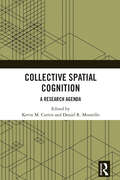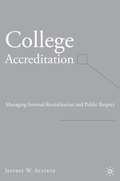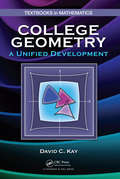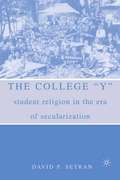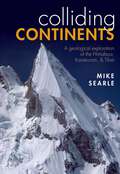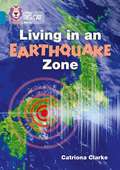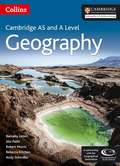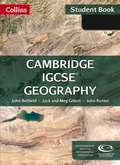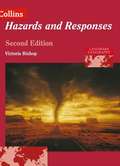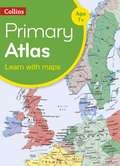- Table View
- List View
Collective Learning for Transformational Change: A Guide to Collaborative Action
by Valerie A. Brown Judith A. LambertThe drive for change has informed human endeavour throughout history. From fields to factories to offices, people have always asked how to make things better. This innovative book offers a step by step guide for recognising the need for transformational change and kick-starting a course of implementation that leads to the creation of a productive, just and sustainable future for the given community. Drawing on over 300 cases of transformational change planned-for and supported through the process of collective learning, the book shows how a collective learning model based on open learning among diverse interests can improve communication and achieve lasting system change. Part one of the book outlines the theory and practice of collective learning, drawing on the experiential learning cycle developed by David Kolb. The practice follows the rules of open space learning, dialogue and valuing diversity and is flexible, allowing adaptation to different situations. Case studies in Part two provide examples of collective learning leading to transformational change in a wide range of contexts, from cities to councils to organisations. Part three offers thirty-three activities on which the programme designers can draw in the course of guiding transformational change, from team building, to community development, monitoring, evaluation and cross-cultural learning This guidebook differs from the traditional management of change. Not only does the process begin with sharing ideals, only later proceeding to implementation, but it also actively harnesses the full set of interests in planning direct action, seeking constructive collaboration not consensus. This groundbreaking guidebook is designed to be fun, accessible and engaging for both students and professionals in the fields of administration and governance.
Collective Learning for Transformational Change: A Guide to Collaborative Action
by Valerie A. Brown Judith A. LambertThe drive for change has informed human endeavour throughout history. From fields to factories to offices, people have always asked how to make things better. This innovative book offers a step by step guide for recognising the need for transformational change and kick-starting a course of implementation that leads to the creation of a productive, just and sustainable future for the given community. Drawing on over 300 cases of transformational change planned-for and supported through the process of collective learning, the book shows how a collective learning model based on open learning among diverse interests can improve communication and achieve lasting system change. Part one of the book outlines the theory and practice of collective learning, drawing on the experiential learning cycle developed by David Kolb. The practice follows the rules of open space learning, dialogue and valuing diversity and is flexible, allowing adaptation to different situations. Case studies in Part two provide examples of collective learning leading to transformational change in a wide range of contexts, from cities to councils to organisations. Part three offers thirty-three activities on which the programme designers can draw in the course of guiding transformational change, from team building, to community development, monitoring, evaluation and cross-cultural learning This guidebook differs from the traditional management of change. Not only does the process begin with sharing ideals, only later proceeding to implementation, but it also actively harnesses the full set of interests in planning direct action, seeking constructive collaboration not consensus. This groundbreaking guidebook is designed to be fun, accessible and engaging for both students and professionals in the fields of administration and governance.
Collective Spatial Cognition: A Research Agenda
by Kevin M. Curtin Daniel R. MontelloThis book integrates the science of spatial cognition and the science of team cognition to explore the social, psychological, and behavioral phenomenon of spatial cognition as it occurs in human collectives such as dyads and work teams.It represents the culmination of a process of outlining and defining a growing field of research termed Collective Spatial Cognition. It engages contributions from an international and multi-disciplinary community of scholars, who have collaborated to provide a foundation for knowledge discovery regarding how groups of people of varying size acquire information and solve problems involving spatiality as a key component, leading to action that incorporates the spatial information and problem-solving collectively achieved. The collectives under study can be as small as dyads (teams of two) to large teams-of-teams who are working alongside each other to complete a mutual goal. The book lays the foundation for multi- and interdisciplinary work regarding Collective Spatial Cognition in the years to come, and this book documents that foundation.This book will be of interest to those researching spatial, behavioural, cognitive, and information sciences in the fields of human geography, sociology, psychology, and computer science.
Collective Spatial Cognition: A Research Agenda
by Kevin Curtin Daniel R. MontelloThis book integrates the science of spatial cognition and the science of team cognition to explore the social, psychological, and behavioral phenomenon of spatial cognition as it occurs in human collectives such as dyads and work teams.It represents the culmination of a process of outlining and defining a growing field of research termed Collective Spatial Cognition. It engages contributions from an international and multi-disciplinary community of scholars, who have collaborated to provide a foundation for knowledge discovery regarding how groups of people of varying size acquire information and solve problems involving spatiality as a key component, leading to action that incorporates the spatial information and problem-solving collectively achieved. The collectives under study can be as small as dyads (teams of two) to large teams-of-teams who are working alongside each other to complete a mutual goal. The book lays the foundation for multi- and interdisciplinary work regarding Collective Spatial Cognition in the years to come, and this book documents that foundation.This book will be of interest to those researching spatial, behavioural, cognitive, and information sciences in the fields of human geography, sociology, psychology, and computer science.
Collective Sustainable Consumption: The Case of Poland (ISSN)
by Anna Horodecka Alina Szypulewska-PorczyńskaIn the face of climate change and resulting environmental and social crises, sustainable consumption has become a widely discussed issue and a key plank of the UN’s Sustainable Development Goals (SDGs). The majority of the sustainable consumption research uses the SDG framework, but this only serves to reinforce an individualistic, efficiency-based approach and it does not sufficiently cover the specific situation of transition economies. In contrast, this volume promotes a collective approach to sustainable consumption, and combines general theoretical issues with empirical examples from the Polish economy. The first part of the book presents a theoretical approach to collective consumption which has the core concepts of justice and human nature at its heart. This approach emphasises the role of collective rationality and categorises aspects of sustainable consumption as a common and public good. The second part investigates diversified aspects of sustainability, including socio-economic inequalities as barriers to sustainable consumption, consumer sovereignty in the context of current legal regulations, and the impact on employees of changes to the types and conditions of work. It also examines the sharing economy and the legal conditions of its development. The third part adopts a political perspective focusing on the state policies enhancing the role of investment in public goods, analyses photovoltaic programmes which promote prosumption and indicates challenges to sustainability faced by many countries such as the energy crisis, sustainable finance, and cooperative platforms.This book will be of great interest to researchers and scholars interested in sustainability and consumption issues in economics, management, law, public administration, and political science.
Collective Sustainable Consumption: The Case of Poland (ISSN)
In the face of climate change and resulting environmental and social crises, sustainable consumption has become a widely discussed issue and a key plank of the UN’s Sustainable Development Goals (SDGs). The majority of the sustainable consumption research uses the SDG framework, but this only serves to reinforce an individualistic, efficiency-based approach and it does not sufficiently cover the specific situation of transition economies. In contrast, this volume promotes a collective approach to sustainable consumption, and combines general theoretical issues with empirical examples from the Polish economy. The first part of the book presents a theoretical approach to collective consumption which has the core concepts of justice and human nature at its heart. This approach emphasises the role of collective rationality and categorises aspects of sustainable consumption as a common and public good. The second part investigates diversified aspects of sustainability, including socio-economic inequalities as barriers to sustainable consumption, consumer sovereignty in the context of current legal regulations, and the impact on employees of changes to the types and conditions of work. It also examines the sharing economy and the legal conditions of its development. The third part adopts a political perspective focusing on the state policies enhancing the role of investment in public goods, analyses photovoltaic programmes which promote prosumption and indicates challenges to sustainability faced by many countries such as the energy crisis, sustainable finance, and cooperative platforms.This book will be of great interest to researchers and scholars interested in sustainability and consumption issues in economics, management, law, public administration, and political science.
The Collector’s Book of Fluorescent Minerals
by Manuel A. RobbinsOver the last several decades, the number of people who are actively involved in the hobby or science of mineral collecting has grown at an increasing pace. In response to the growing demand for informa tion which this large and active group has created, a number of books have been published dealing with mineralogy. As a result, the reader now has a choice among mineral locality guides, field handbooks, photo collections, or books dedicated to the systematic description of minerals. However, as interest in mineralogy has grown, as collectors have become increasingly knowledgeable and aware of mineralogy in its many facets, the need for more specialized information has also grown. Nowhere is this need greater than in the subject of the fluorescence of minerals. The number of collectors who now main tain a fluorescent collection is substantial, interest is constantly increasing, and manufacturers have recently responded by the intro duction of new ultraviolet equipment with major improvements in utility and performance. Yet when the collector searches for any information on this subject, little will be found. He or she will seek in vain for the answers to questions which present themselves as in terest in fluorescent minerals grows and matures. Which minerals fluoresce? Where are fluorescent minerals found? What makes a mineral fluoresce? Why does ultraviolet light produce fluorescence? What is an activator, and how does it contribute to fluorescence? On these matters, the available mineralogy books are largely silent.
College Accreditation: Managing Internal Revitalization and Public Respect
by J. AlsteteThis book is an informative resource on college accreditation today and explains how colleges and universities can manage the accreditation process successfully. Readers will learn the history of accreditation, and how effective management of accreditation can help internal revitalization and improve public respect for their institutions.
College Geometry: A Unified Development (Textbooks In Mathematics Ser.)
by David C. KayDesigned for mathematics majors and other students who intend to teach mathematics at the secondary school level, College Geometry: A Unified Development unifies the three classical geometries within an axiomatic framework. The author develops the axioms to include Euclidean, elliptic, and hyperbolic geometry, showing how geometry has real and far-
The College "Y": Student Religion in the Era of Secularization
by D. SetranPlease note this is a 'Palgrave to Order' title (PTO). Stock of this book requires shipment from an overseas supplier. It will be delivered to you within 12 weeks. In this groundbreaking history of the YMCA, David Setran details its critical role on American campuses, exploring how this popular organization worked to strengthen the Protestant piety of American collegians through Bible study, service, and prayer, as well as how the organization changed after World War I, alienating itself from churches, university administrators, and even the students themselves.
Colliding Continents: A Geological Exploration Of The Himalaya, Karakoram, And Tibet
by Mike SearleThe crash of the Indian plate into Asia is the biggest known collision in geological history, and it continues today. The result is the Himalaya and Karakoram - one of the largest mountain ranges on Earth. The Karakoram has half of the world's highest mountains and a reputation as being one of the most remote and savage ranges of all. In this beautifully illustrated book, Mike Searle, a geologist at the University of Oxford and one of the most experienced field geologists of our time, presents a rich account of the geological forces that were involved in creating these mountain ranges. Using his personal accounts of extreme mountaineering and research in the region, he pieces together the geological processes that formed such impressive peaks.
Collins Big Cat, Band 13, Topaz: Living in an Earthquake Zone (PDF)
by Catriona Clarke Collins Big Cat StaffWhat's it really like to live in an earthquake zone and how do people know when one's about to happen? Explore where and why earthquakes take place and what to do when one strikes. *Topaz/Band 13 books offer longer and more demanding reads for children to investigate and evaluate. * Text type - An information book. * The book is organised into short chapters to help children practise the skills of locating and identifying important information. * The glossary and index on page 29 can be used to develop children's information retrieval skills further. * Curriculum links - Geography - physical geography
Collins Big Cat, Band 13, Topaz: A Finders’ Guide to Rocks, Fossils and Soils (PDF)
by Alison Milford Collins Big Cat StaffJoin the experts on their field trip and discover how the rocks, fossils and soils are a vital part of our planet. * Topaz/Band 13 books offer longer and more demanding reads for children to investigate and evaluate. * Text type - An information book. * The book is organised into short chapters to help children practise the skills of locating and identifying important information. * The glossary and index on pages 30 and 31 can be used to develop children's information retrieval skills further. * Curriculum links - Science - Rocks; Geography - Natural resources
Collins Big Cat, Band 13, Topaz, Wind Power (PDF)
by Emily Dodd Collins Big Cat StaffWind power is used more and more around the world to give us electricity in our homes. But what is wind? How can it be used to make electricity and why is it replacing other forms of energy? Find out in this book. * Topaz/Band 13 books offer longer and more demanding reads for children to investigate and evaluate. * Text type - An information book. * The book is organised into short chapters to help children practise the skills of locating and identifying important information. * The glossary and index on pages 28 and 29 can be used to develop children's information retrieval skills further. * Curriculum links - Science - Electricity
Collins Big Cat, Band 14, Ruby: What's Up with Time? (PDF)
by Becca Heddle Alan Rowe Collins Big Cat StaffHow do we measure time, and where does it come from? How do clocks work - and what happened before they were invented? Find out the fascinating answers inside. * Ruby/Band 14 books give increasing opportunities for children to develop their skills of inference and deduction. * Text type - An information book. * The book is organised into short chapters to help children practise the skills of locating and identifying important information. * The glossary and index on page 44 can be used to develop children's information retrieval skills further. * Curriculum links - Mathematics - measurement; History - chronological understanding
Collins Big Cat, Band 14, Ruby: Welcome to My City (PDF)
by Charlotte Raby Collins Big Cat StaffCome on a tour of four exciting - and very different - cities! Find out what it's like to live in Bristol, Paris, Los Angeles and Abu Dhabi, and discover: * fun things to do * important landmarks and history * how the local landscape and climate have affected life in each city. * Ruby/Band 14 books give increasing opportunities for children to develop their skills of inference and deduction. * Text type - An information book. * The book is organised into short chapters to help children practise the skills of locating and identifying important information. * The glossary and index on pages 44 and 45 can be used to develop children's information retrieval skills further. * Curriculum links - Geography - locational knowledge
COLLINS CAMBRIDGE AS AND A LEVEL GEOGRAPHY STUDENT BOOK (PDF)
by Collins Uk Rebecca Kitchen Barnaby Lenon Robert Morris Iain Palot Andy SchindlerWritten by team of experienced geography teachers, this Student Book is fully matched to the Cambridge A and AS Level Geography syllabus. Collins Cambridge AS/A Level Geography Student Book covers all the core syllabus topics as well as the physical and human geography options. The aim of the book is to help the student to obtain the knowledge, understanding and skills to succeed in their geographical studies. The content is accessible and clearly organised with a student friendly layout. The depth of content coverage is suitable for the whole range of abilities. Illustrated throughout, it contains a wealth of maps, diagrams and info-graphics to support the interesting and current case studies taken from around the world. Content Hydrology and fluvial geomorphology Atmosphere and weather Rocks and weathering Population Migration Settlement dynamics Tropical environments Coastal environments Hazardous environments Hot arid and semi-arid environments Production, location and change Environmental management Global interdependence Economic transition Geographical skills
Collins Cambridge IGCSE - Cambridge IGCSE Geography Student Book (PDF)
by Jack Gillett John Rutter John Belfield Meg GillettAn investigative approach to Cambridge IGCSE Geography, written in partnership with the Geographical Association. Encourage students to make links between case studies and their own local contexts as well as exploring the core themes and skills of the 0460 syllabus in the context of global case studies and processes.
Collins GCSE 9-1 Revision — AQA GCSE 9-1 Geography Workbook (PDF)
by Collins GcseExam Board: AQA Level: GCSE 9-1 Subject: Geography First Teaching: September 2016, First Exams: June 2018 This Collins AQA Geography GCSE 9-1 Workbook contains topic-based questions as well as a full practice paper and answers. With lots of realistic practice opportunities for a variety of different exam-style questions. With a workbook and practice exam paper in one book, it contains plenty of practice opportunities to ensure the best results. Includes: • selection of questions covering each topic • topic-by-topic practice • complete exam-style paper
Collins GCSE Grade 9-1 Revision — AQA GCSE 9-1 GEOGRAPHY COMPLETE REVISION & PRACTICE: Ideal For Home Learning, 2023 And 2024 Exams
by Collins GcseCollins GCSE Grade 9-1 Revision — AQA GCSE 9-1 GEOGRAPHY WORKBOOK: Ideal For Home Learning, 2023 And 2024 Exams
by Collins GcseCollins A Level Geography - Landmark Geography Hazards and Responses (PDF)
by Victoria BishopThis text examines hazards and responses. The book provides relevant case studies and employs a range of scales and locations to discuss economically developed, developing and newly industrialised countries.
Collins Primary Atlas [Fifth edition] (PDF)
by Collins MapsProviding an introduction to mapping of all major regions of the world, this reference includes information on map reading skills, the meaning of scale and measuring distances. The reference maps are informative, politically colored, and easy to read with national capitals and major cities easily identifiable. The maps are supported with national flags and basic national statistics. Continental maps are linked to the regional mapping and are supported by a selection of aerial and terrestrial photographs. Continental relief maps show layer coloring and major physical features are highlighted. The index uses a simple grid reference system, and a selection of web addresses is included to help with further study.

